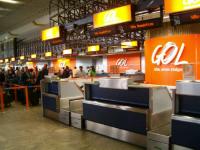GOL Linhas Aéreas Inteligentes S.A. (Bovespa: GOLL4 and NYSE: GOL), the largest low-cost and low-fare airline in Latin America, announces its preliminary traffic figures for October 2009.
São Paulo – GOL Linhas Aéreas Inteligentes S.A. (Bovespa: GOLL4 and NYSE: GOL), the largest low-cost and low-fare airline in Latin America, announces its preliminary traffic figures for October 2009.
Management Comments
In October, GOL recorded demand growth in the domestic market of 46.9% over the same month last year, chiefly due to the Company’s privileged positioning in that market, with high-frequency flights between airports in densely populated cities and dynamic yield management, underpinned by high-quality service, punctuality and regularity. In addition, the month’s figures were still reflecting the upturn in demand triggered by the exceptionally competitive scenario in September and the first ten days of October.
Thanks to the above-mentioned differentials and the efforts of its sales area, GOL is also highly competitive in the corporate market. According to TMC Brasil, the business travel operators’ association (www.tmcbrasil.com.br), GOL’s share of sales through the association’s affiliates increased by 6.1 percentage points, from 34.2% in the first half of 2008 to 40.3% in the same period in 2009.
For the same reasons, domestic demand climbed by 14.1% over September 2009, or 10.4% if the number of calendar days in each month (30 in September and 31 in October) are equalized.
International market demand fell by 7.2% over October 2008, due to the reduction in the number of seats on certain routes (or reduced frequencies), designed to maximize operating profitability. In relation to September 2009, international demand moved up by 11.2%, thanks to the recovery of traffic on Chilean and Argentinean routes, given the decline in the number of H1N1 flu cases due to the end of winter.
Operating Data October 2009* October 2008* % Chg. (YoY) September 2009* % Chg. (MoM)
Total System
ASK (mm) (1) 3,455.6 3,151.7 9.6% 3,289.6 5.0%
RPK (mm) (2) 2,485.8 1,790.0 38.9% 2,184.6 13.8%
Load Factor (3) 71.9% 56.8% +15.1pp 66.4% +5.5pp
Domestic Market
ASK (mm) (1) 3,077.3 2,665.3 15.5% 2,922.1 5.3%
RPK (mm) (2) 2,238.9 1,524.1 46.9% 1,962.6 14.1%
Load Factor (3) 72.8% 57.2% +15.6pp 67.2% +5.6pp
International Market
ASK (mm) (1) 378.3 486.4 -22.2% 367.5 2.9%
RPK (mm) (2) 246.9 265.9 -7.2% 222.0 11.2%
Load Factor (3) 65.2% 54.7% +10.6pp 60.4% +4.8pp
GOL continued with its efforts to improve capacity in order to maximize its operating results, and October’s numbers clearly reflect this strategy, recording a 15.5% domestic market increase over October 2008, equivalent to around 1/3 of its total demand growth in the same month. In the same period, the load factor increased by 15.6 p.p. to 72.8%. In comparison with September 2009, the load factor grew by 5.6 p.p. Although the highly competitive price scenario began to ease off in the first week of October, it was during this period that most tickets for October flights were sold, maintaining the average net yield at close to 17.00 cents (R$). In addition, sales for November and December 2009 are already showing clear signs of a recovery. (1) Available seat kilometers, or ASK, represents the aircraft seating capacity multiplied by the number of kilometers the seats are flown. (2) Revenue passenger kilometers, or RPK, represents the number of kilometers flown by revenue passengers. (3) Load factor represents the percentage of aircraft seating capacity that is actually utilized (calculated by dividing RPK by ASK).
Picture: Carstino Delmonte/ Touristikpresse.net






